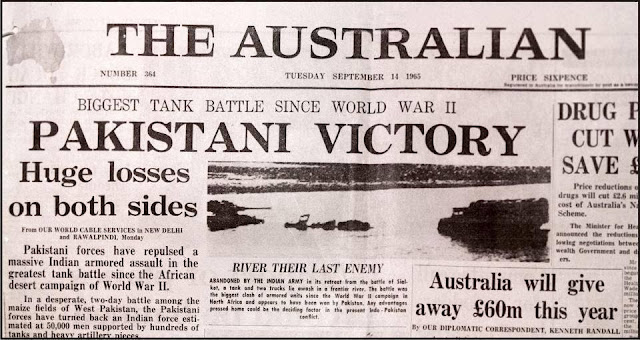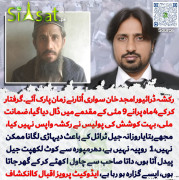RiazHaq
Senator (1k+ posts)
[h=3]Detailed Account of Fear and Panic Gripping Indian Army in 1965 War[/h]
A full-page Indian Army advertisement published in major Hindi national dailies recently says that the Indian forces responded to the Pakistan attack with fear (darkar muqabala kiya). It was later clarified as a typographical error which changed "datkar muqabla kiya" to "darkar muqabla kiya".
[TABLE="class: tr-caption-container"]
[TR]
[TD]
 [/TD]
[/TD]
[/TR]
[TR]
[TD="class: tr-caption"]
[/TR]
[/TABLE]
Freudian Slip?
Let's examine whether the typo was in fact a Freudian slip: An unintentional error that revealed the real truth. The best source to examine it is "1965 War: The Inside Story", an authoritative book on 1965 war written by RD Pradhan who was personal assistant to Indian Defense Minister Y.B. Chavan in 1965. Mr. Pradhan has based his book on Mr. Chavan's diaries kept during the war.
Indian Cowardice and Panic:
Mr. Pradhan has devoted an entire chapter of his book to how General Jayanto Nath Chaudhuri, the Indian Army Chief, badly panicked when Pakistani forces mounted a fierce counter-attack during 1965 war. At one point, Gen Chaudhuri ordered Gen Harbakhash Singh to pull back behind the Beas, essentially leaving much of Indian Punjab to Pakistan.
In Chapter 8 titled "Of Cowardice and Panic" of his book "1965 War-The Inside Story", R.D. Pradhan describes the cowardice of Maj. Gen. Niranjan Prasad, the Indian general commanding officer in Kasur sector. When Pakistan Defense Forces counter-attacked the intruding Indian military and the general was fired upon on Sept 6, 1965, he "ran away". Here's an excerpt:
"On learning that, Lt. Gen. Harbakash Singh and the corps commander drove in a Jonga (Nissan P60 Jeep) to the battlefront. Army commander found that the enemy (PAF) air attack had created a havoc on G.T. Road. (Indian) Vehicles were burning and several vehicles of 15 Division abandoned on the road, the drivers having run away, leaving some of the engines still running.
Maj. Gen. Niranjan Prasad was hiding in a recently irrigated sugar cane field. As described by Harabakash Singh: "He (Prasad) came out to receive us, with his boots covered with wet mud. He had no head cover, nor was he wearing any badges of his rank. He had stubble on his face, not having shaved." Seeing him in such a stage, Harbakhash Singh asked him: "Whether he was the General Officer commanding a division or a coolie? Why had he removed badges of rank and not shaved? Niranjan Prasad had no answer."
Retreat to Beas:
Chapter 12 of Pradhan's book is titled "Retreat to Beas" in which there is detailed discussion of Indian COAS's proposal for the Indian Army to retreat behind Beas in the face of Pakistan's fierce counter-attacks after India's attempted incursion in Lahore. Pradhan argues in this chapter that during the 1965 war with Pakistan, Indian COAS General Chaudhuri feared that "a major battle the west of the Beas would end in the destruction of the Indian Army and thereafter allow the enemy (Pakistani) forces to push to the gates of Delhi without much resistance".

Pradhan's book contains many different entries by Indian Defense Minister Y.B. Chavan. A Sept 9, 1965 entry reads:
Had a very hard day on all fronts. Very fierce counter-attacks mounted and we are required to withdraw in Kasur area. COAS was somewhat uncertain of himself. I suggested to him that he should go in forward areas so that he will be in touch of realities. He said he would go next day.
Harbakhash Singh Memoirs:
In Line of Duty: A Soldier Remembers, according to Shekhar Gupta, the editor of Indian Express, Lt Gen Harbakhsh Singh reveals that not only "did Gen Chowdhury play a very small role in the entire campaign, he was so nervous as to be on the verge of losing half of Punjab to Pakistan, including the city of Amritsar. Harbakhsh describes, in clinical detail, how our own offensive in the Lahore sector had come unhinged.
The general commanding the division on Ichchogil canal fled in panic, leaving his jeep, its wireless running and the briefcase containing sensitive documents that were then routinely read on Radio Pakistan during the war. Singh wanted to court martial him, Chowdhury let him get away with resignation".
According to Shekhar Gupta, Harbkhash Singh recounts that a bigger disaster struck a bit to the south where the other division cracked up in assault, just as it encountered a bit of resistance. Several infantry battalions, short on battle inoculation, deserted and Singh gives a hair-raising account – and confirmation of a long-debated rumor – that Chowdhury panicked so badly he ordered him to withdraw to a new defensive line behind the Beas, thereby conceding half of Punjab to Pakistan.
Singh describes the conversation with Chowdhury at Ambala where he refused to carry out the order, asking his chief to either put it down in writing or visit the front and take charge of the battle.

India was the first to accept UN sponsored ceasefire (page 100 of RD Pradhan's book) on Sept 21 followed by Pakistan on Sept 22, bringing the 1965 war to an end on Sept 22, 1965. As the ceasefire took effect, Indian Defense Y.B. Chavan wrote in his diary as follows:
"The ball is now in the political court again--where it should be--and not in the military one. I hope we have the vision and courage to (our) political leadership."
Summary:
Alas, the core issue of Kashmir still remains unresolved 48 years since Mr. Chavan wrote his words of wisdom. And, unfortunately, India's Hindu Nationalist Prime Minister Narendra Modi refuses to even talk about the Kashmir issue, much less resolve it.
http://www.riazhaq.com/2015/08/detailed-account-of-fear-and-panic.html
A full-page Indian Army advertisement published in major Hindi national dailies recently says that the Indian forces responded to the Pakistan attack with fear (darkar muqabala kiya). It was later clarified as a typographical error which changed "datkar muqabla kiya" to "darkar muqabla kiya".
[TABLE="class: tr-caption-container"]
[TR]
[TD]

[/TR]
[TR]
[TD="class: tr-caption"]
An ad in a national Hindi daily saying India ‘countered the Pakistan attack with fear (darkar muqabala kiya)’
[/TD][/TR]
[/TABLE]
Freudian Slip?
Let's examine whether the typo was in fact a Freudian slip: An unintentional error that revealed the real truth. The best source to examine it is "1965 War: The Inside Story", an authoritative book on 1965 war written by RD Pradhan who was personal assistant to Indian Defense Minister Y.B. Chavan in 1965. Mr. Pradhan has based his book on Mr. Chavan's diaries kept during the war.
Indian Cowardice and Panic:
Mr. Pradhan has devoted an entire chapter of his book to how General Jayanto Nath Chaudhuri, the Indian Army Chief, badly panicked when Pakistani forces mounted a fierce counter-attack during 1965 war. At one point, Gen Chaudhuri ordered Gen Harbakhash Singh to pull back behind the Beas, essentially leaving much of Indian Punjab to Pakistan.
In Chapter 8 titled "Of Cowardice and Panic" of his book "1965 War-The Inside Story", R.D. Pradhan describes the cowardice of Maj. Gen. Niranjan Prasad, the Indian general commanding officer in Kasur sector. When Pakistan Defense Forces counter-attacked the intruding Indian military and the general was fired upon on Sept 6, 1965, he "ran away". Here's an excerpt:
"On learning that, Lt. Gen. Harbakash Singh and the corps commander drove in a Jonga (Nissan P60 Jeep) to the battlefront. Army commander found that the enemy (PAF) air attack had created a havoc on G.T. Road. (Indian) Vehicles were burning and several vehicles of 15 Division abandoned on the road, the drivers having run away, leaving some of the engines still running.
Maj. Gen. Niranjan Prasad was hiding in a recently irrigated sugar cane field. As described by Harabakash Singh: "He (Prasad) came out to receive us, with his boots covered with wet mud. He had no head cover, nor was he wearing any badges of his rank. He had stubble on his face, not having shaved." Seeing him in such a stage, Harbakhash Singh asked him: "Whether he was the General Officer commanding a division or a coolie? Why had he removed badges of rank and not shaved? Niranjan Prasad had no answer."
Retreat to Beas:
Chapter 12 of Pradhan's book is titled "Retreat to Beas" in which there is detailed discussion of Indian COAS's proposal for the Indian Army to retreat behind Beas in the face of Pakistan's fierce counter-attacks after India's attempted incursion in Lahore. Pradhan argues in this chapter that during the 1965 war with Pakistan, Indian COAS General Chaudhuri feared that "a major battle the west of the Beas would end in the destruction of the Indian Army and thereafter allow the enemy (Pakistani) forces to push to the gates of Delhi without much resistance".

Pradhan's book contains many different entries by Indian Defense Minister Y.B. Chavan. A Sept 9, 1965 entry reads:
Had a very hard day on all fronts. Very fierce counter-attacks mounted and we are required to withdraw in Kasur area. COAS was somewhat uncertain of himself. I suggested to him that he should go in forward areas so that he will be in touch of realities. He said he would go next day.
Harbakhash Singh Memoirs:
In Line of Duty: A Soldier Remembers, according to Shekhar Gupta, the editor of Indian Express, Lt Gen Harbakhsh Singh reveals that not only "did Gen Chowdhury play a very small role in the entire campaign, he was so nervous as to be on the verge of losing half of Punjab to Pakistan, including the city of Amritsar. Harbakhsh describes, in clinical detail, how our own offensive in the Lahore sector had come unhinged.
The general commanding the division on Ichchogil canal fled in panic, leaving his jeep, its wireless running and the briefcase containing sensitive documents that were then routinely read on Radio Pakistan during the war. Singh wanted to court martial him, Chowdhury let him get away with resignation".
According to Shekhar Gupta, Harbkhash Singh recounts that a bigger disaster struck a bit to the south where the other division cracked up in assault, just as it encountered a bit of resistance. Several infantry battalions, short on battle inoculation, deserted and Singh gives a hair-raising account – and confirmation of a long-debated rumor – that Chowdhury panicked so badly he ordered him to withdraw to a new defensive line behind the Beas, thereby conceding half of Punjab to Pakistan.
Singh describes the conversation with Chowdhury at Ambala where he refused to carry out the order, asking his chief to either put it down in writing or visit the front and take charge of the battle.

India was the first to accept UN sponsored ceasefire (page 100 of RD Pradhan's book) on Sept 21 followed by Pakistan on Sept 22, bringing the 1965 war to an end on Sept 22, 1965. As the ceasefire took effect, Indian Defense Y.B. Chavan wrote in his diary as follows:
"The ball is now in the political court again--where it should be--and not in the military one. I hope we have the vision and courage to (our) political leadership."
Summary:
Alas, the core issue of Kashmir still remains unresolved 48 years since Mr. Chavan wrote his words of wisdom. And, unfortunately, India's Hindu Nationalist Prime Minister Narendra Modi refuses to even talk about the Kashmir issue, much less resolve it.
http://www.riazhaq.com/2015/08/detailed-account-of-fear-and-panic.html
Last edited by a moderator:




































